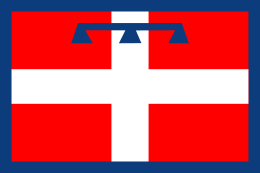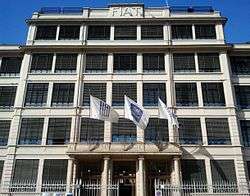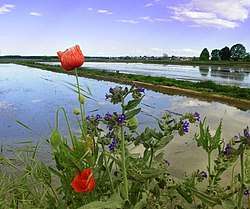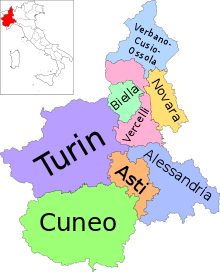Piedmont
Piedmont (/ˈpiːdmɒnt/ PEED-mont; Italian: Piemonte, pronounced [pjeˈmonte]; Piedmontese, Occitan and Francoprovençal: Piemont, Piedmontese pronunciation: [pjeˈmʊŋt]) is a region in northwest Italy, one of the 20 regions of the country.[4] It borders the Liguria region to the south, the Lombardy and Emilia-Romagna regions to the east and the Aosta Valley region to the northwest; it also borders Switzerland to the northeast and France to the west. It has an area of 25,402 square kilometres (9,808 sq mi) making it the second largest region of Italy after Sicily and a population of 4,377,941 as of 30 November 2017. The capital of Piedmont is Turin.
Piedmont | |
|---|---|
Region of Italy | |
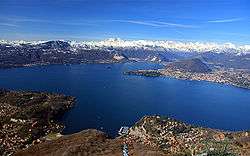 A view over Piedmont's Lake Maggiore, Mount Rosa, and Verbania | |
 Coat of arms | |
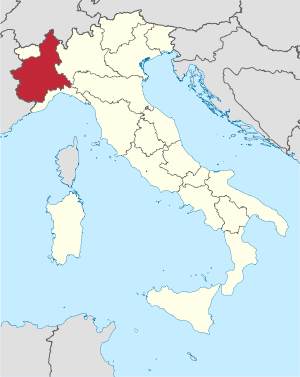 | |
| Country | Italy |
| Capital | Turin |
| Government | |
| • President | Alberto Cirio (FI) |
| Area | |
| • Total | 25,402 km2 (9,808 sq mi) |
| Population (31-10-2017) | |
| • Total | 4,377,941 |
| • Density | 170/km2 (450/sq mi) |
| Demonym(s) | English: Piedmontese Italian: Piemontese |
| Time zone | UTC+1 (CET) |
| • Summer (DST) | UTC+2 (CEST) |
| ISO 3166 code | IT-21 |
| GDP (nominal) | €137 billion (2018)[1] |
| GDP per capita | €31,300 (2018)[2] |
| HDI (2018) | 0.888[3] very high · 10th of 21 |
| NUTS Region | ITC1 |
| Website | www.regione.piemonte.it |
Toponymy
The name Piedmont comes from medieval Latin Pedemontium or Pedemontis, i.e., ad pedem montium, meaning "at the foot of the mountains" (the Alps), attested in documents from the end of the 12th century.[5]
Geography
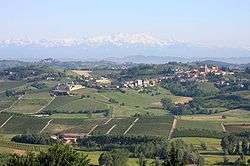
Piedmont is surrounded on three sides by the Alps, including Monviso, where the Po rises, and Monte Rosa. It borders with France (Auvergne-Rhône-Alpes and Provence-Alpes-Côte d'Azur), Switzerland (Ticino and Valais) and the Italian regions of Lombardy, Liguria, Aosta Valley and for a very small part with Emilia Romagna. The geography of Piedmont is 43.3% mountainous, along with extensive areas of hills (30.3%) and plains (26.4%).
Piedmont is the second largest of Italy's 20 regions, after Sicily. It is broadly coincident with the upper part of the drainage basin of the river Po, which rises from the slopes of Monviso in the west of the region and is Italy's largest river. The Po drains the semicircle formed by the Alps and Apennines, which surround the region on three sides.
From the highest peaks, the land slopes down to hilly areas, (sometimes with a brusque transition from mountain to plain) and then to the Padan Plain. The boundary between the two is characterised by resurgent springs—typical of the Padan Plain—which supply fresh water to the rivers and a dense network of irrigation canals.
The countryside is very diverse: from the rugged peaks of the massifs of Monte Rosa and Gran Paradiso to the damp rice paddies of Vercelli and Novara, from the gentle hillsides of the Langhe, Roero and Montferrat to the plains. 7.6% of the entire territory is considered protected area. There are 56 different national or regional parks; one of the most famous is the Gran Paradiso National Park, between Piedmont and the Aosta Valley.
Major towns and cities
| Population rank | City Name | Population (ab) |
Surface (km2) |
Density (ab/km2) |
Altitude (m s.l.m.) |
Province or metropolitan city |
|---|---|---|---|---|---|---|
| 1 | Turin | 883.281 | 130,17 | 6.786 | 239 | TO |
| 2 | Novara | 104.411 | 103,05 | 1.013 | 162 | NO |
| 3 | Alessandria | 93.884 | 203,97 | 460 | 95 | AL |
| 4 | Asti | 76.424 | 151,82 | 504 | 123 | AT |
| 5 | Moncalieri | 57.060 | 47,63 | 1.197 | 260 | TO |
| 6 | Cuneo | 56.116 | 119,88 | 468 | 534 | CN |
| 7 | Collegno | 49.940 | 18,12 | 2.756 | 302 | TO |
| 8 | Rivoli | 48.819 | 29,52 | 1.653 | 390 | TO |
| 9 | Nichelino | 48.182 | 20,64 | 2.334 | 229 | TO |
| 10 | Settimo Torinese | 47.704 | 32,37 | 1.473 | 207 | TO |
Other towns of Piedmont with more than 20,000 inhabitants sorted by population :
| Population rank | City Name | Population (ab) |
Surface (km2) |
Density (ab/km2) |
Altitude (m s.l.m.) |
Province or metropolitan city |
|---|---|---|---|---|---|---|
| 11 | Vercelli | 46.808 | 79,85 | 586 | 130 | VC |
| 12 | Biella | 44.860 | 46,68 | 961 | 417 | BI |
| 13 | Grugliasco | 37.906 | 13,12 | 2.889 | 293 | TO |
| 14 | Chieri | 36.778 | 54,30 | 677 | 305 | TO |
| 15 | Pinerolo | 35.778 | 50,28 | 711 | 376 | TO |
| 16 | Casale Monferrato | 34.565 | 86,32 | 400 | 116 | AL |
| 17 | Venaria Reale | 34.248 | 20,29 | 1.687 | 262 | TO |
| 18 | Alba | 31.419 | 54,01 | 581 | 172 | CN |
| 19 | Verbania | 30.933 | 36,62 | 844 | 197 | VB |
| 20 | Bra | 29.705 | 59,61 | 498 | 285 | CN |
| 21 | Carmagnola | 29.052 | 96,38 | 301 | 240 | TO |
| 22 | Novi Ligure | 28.257 | 54,22 | 521 | 199 | AL |
| 23 | Tortona | 27.575 | 99,29 | 278 | 122 | AL |
| 24 | Chivasso | 26.704 | 51,31 | 520 | 183 | TO |
| 25 | Fossano | 24.743 | 130,72 | 189 | 375 | CN |
| 26 | Ivrea | 23.598 | 30,19 | 781 | 253 | TO |
| 27 | Orbassano | 23.240 | 22,05 | 1.053 | 273 | TO |
| 28 | Mondovì | 22.592 | 87,25 | 258 | 395 | CN |
| 29 | Borgomanero | 21.709 | 32,36 | 670 | 307 | NO |
| 30 | Savigliano | 21.306 | 110,73 | 192 | 321 | CN |
| 31 | Trecate | 20.329 | 38,38 | 529 | 136 | NO |
| 32 | Acqui Terme | 20.054 | 33,30 | 602 | 156 | AL |
History
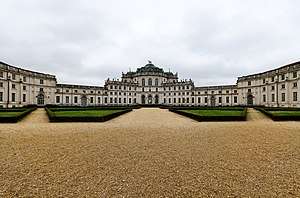
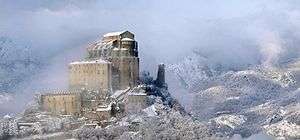
Piedmont was inhabited in early historic times by Celtic-Ligurian tribes such as the Taurini and the Salassi. They were later subdued by the Romans (c. 220 BC), who founded several colonies there including Augusta Taurinorum (Turin) and Eporedia (Ivrea). After the fall of the Western Roman Empire, the region was successively invaded by the Burgundians, the Ostrogoths (5th century), East Romans, Lombards (6th century), and Franks (773).
In the 9th–10th centuries there were further incursions by the Magyars, Saracens and Muslim Moors.[6] At the time Piedmont, as part of the Kingdom of Italy within the Holy Roman Empire, was subdivided into several marches and counties.
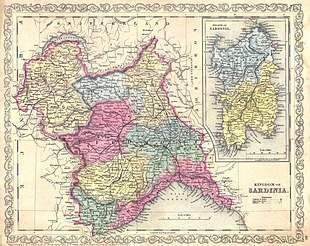
In 1046, Oddo of Savoy added Piedmont to the County of Savoy, with a capital at Chambéry (now in France). Other areas remained independent, such as the powerful comuni (municipalities) of Asti and Alessandria and the marquisates of Saluzzo and Montferrat. The County of Savoy became the Duchy of Savoy in 1416, and Duke Emanuele Filiberto moved the seat to Turin in 1563. In 1720, the Duke of Savoy became King of Sardinia, founding what evolved into the Kingdom of Sardinia and increasing Turin's importance as a European capital.
The Republic of Alba was created in 1796 as a French client republic in Piedmont. A new client republic, the Piedmontese Republic, existed between 1798 and 1799 before it was reoccupied by Austrian and Russian troops. In June 1800 a third client republic, the Subalpine Republic, was established in Piedmont. It fell under full French control in 1801 and it was annexed by France in September 1802. In the Congress of Vienna, the Kingdom of Sardinia was restored, and furthermore received the Republic of Genoa to strengthen it as a barrier against France.
Piedmont was a springboard for Italian unification in 1859–1861, following earlier unsuccessful wars against the Austrian Empire in 1820–1821[7] and 1848–1849. This process is sometimes referred to as Piedmontisation.[8] However, the efforts were later countered by the efforts of rural farmers.[9][10]
The House of Savoy became Kings of Italy, and Turin briefly became the capital of Italy. However, when the Italian capital was moved to Florence, and then to Rome, the administrative and institutional importance of Piedmont was reduced. The only recognition of Piedmont's historical role was that the crown prince of Italy was known as the Prince of Piedmont. After Italian unification, Piedmont was one of the most important regions in the first Italian industrialization.[11]
Economy
The region contains major industrial centres, the most important of which is Turin, home to the FIAT automobile works. Olivetti, once a major electronics industry whose plants were in Scarmagno and Ivrea, has now turned into a small-scale computer service company. Biella produces wool, tissues and silks. Alba is the home of Ferrero's chocolate factories and some mechanical industries.
Since 2006, the Piedmont region has benefited from the start of the Slow Food movement and Terra Madre, events that highlighted the rich agricultural and viticultural value of the Po valley and northern Italy. In the same year, the Piemonte Agency for Investments, Export and Tourism began to facilitate outside investment and promote Piedmont's industry and tourism. It was the first Italian institution to combine the activities being carried out by pre-existing local organizations to promote the territory internationally.
The gross domestic product (GDP) of the region was 137.4 billion euros in 2018, accounting for 7.8% of Italy's GDP. GDP per capita at purchasing power parity was 31,300 euros or 104% of the EU27 average in the same year. The GDP per employee was 111% of the EU average.[12]
The unemployment rate stood at 8.2% in 2018.[13][14]
| Year | 2006 | 2007 | 2008 | 2009 | 2010 | 2011 | 2012 | 2013 | 2014 | 2015 | 2016 | 2017 | 2018 |
|---|---|---|---|---|---|---|---|---|---|---|---|---|---|
| Unemployment rate | 4.1% | 4.2% | 5.1% | 6.8% | 7.5% | 7.6% | 9.2% | 10.5% | 11.3% | 10.2% | 9.3% | 9.1% | 8.2% |
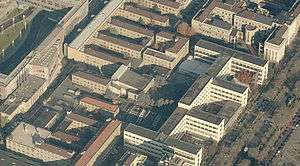
Agriculture
Lowland Piedmont is a fertile agricultural region. The main agricultural products in Piedmont are cereals, including rice, representing more than 10% of national production, maize, grapes for wine-making, fruit and milk.[15] With more than 800,000 head of cattle in 2000, livestock production accounts for half of total agricultural production in Piedmont.
Piedmont is one of the great winegrowing regions in Italy. More than half of its 700 square kilometres (170,000 acres) of vineyards are registered with DOC designations. It produces prestigious wines as Barolo and Barbaresco from the Langhe near Alba, and the Moscato d'Asti and sparkling Asti from the vineyards around Asti. The city of Asti is about 55 kilometres (34 miles) east of Turin in the plain of the Tanaro River and is one of the most important centres of Montferrat, one of the best known Italian wine districts in the world, declared officially on 22 June 2014 a UNESCO World Heritage site.[16] Indigenous grape varieties include Nebbiolo, Barbera, Dolcetto, Freisa, Grignolino and Brachetto.
Tourism
Tourism in Piedmont employs 75,534 people and involves 17,367 companies operating in the hospitality and catering sector, with 1,473 hotels and other tourist accommodation. The sector generates a turnover of €2,671 million, 3.3% of the €80,196 million total estimated spending on tourism in Italy. The region is popular with both foreign visitors and those from other parts of Italy. In 2002 there were 2,651,068 total arrivals, 1,124,696 (42%) of whom were foreign. The traditional leading areas for tourism in Piedmont are the Lake District ("Piedmont's riviera"), which accounts for 32.84% of total overnight stays, and the metropolitan area of Turin, which accounts for 26.51%.[17]
In 2006, Turin hosted the XX Olympic Winter Games and in 2007 it hosted the XXIII Universiade. Alpine tourism tends to concentrate in a few highly developed stations like Alagna Valsesia and Sestriere. Around 1980, the long-distance trail Grande Traversata delle Alpi (GTA) was created to draw more attention to the variety of remote, sparsely inhabited valleys.
Transport
There are links with neighbouring France via the Fréjus and Colle di Tenda tunnels as well as the Montgenèvre Pass. Piedmont also connects with Switzerland by the Simplon and Great St Bernard passes. It is possible to reach Switzerland via a normal road that crosses eastern Piedmont, starting from Arona and ending in Locarno, on the Swiss border. Turin International Airport has domestic and international flights.[15] The region has the longest motorway network amongst the Italian regions (about 800 km). It radiates from Turin, connecting it with the other provinces in the region, as well as with the other regions in Italy. In 2001, the number of passenger cars per 1,000 inhabitants was 623 (above the national average of 575).[15]
Education
The economy of Piedmont is anchored on a rich history of state support for higher education, including some of the leading universities in Italy. Piedmont is home to the famous University of Turin, the Polytechnic University of Turin, the University of Eastern Piedmont and, more recently the United Nations Interregional Crime and Justice Research Institute.[18]
Demographics
| Year | Pop. | ±% |
|---|---|---|
| 1861 | 2,759,000 | — |
| 1871 | 2,928,000 | +6.1% |
| 1881 | 3,090,000 | +5.5% |
| 1901 | 3,319,000 | +7.4% |
| 1911 | 3,414,000 | +2.9% |
| 1921 | 3,439,000 | +0.7% |
| 1931 | 3,458,000 | +0.6% |
| 1936 | 3,418,000 | −1.2% |
| 1951 | 3,518,000 | +2.9% |
| 1961 | 3,914,000 | +11.3% |
| 1971 | 4,432,000 | +13.2% |
| 1981 | 4,479,000 | +1.1% |
| 1991 | 4,303,000 | −3.9% |
| 2001 | 4,215,000 | −2.0% |
| 2010 (Est.) | 4,456,000 | +5.7% |
| 2017 | 4,392,526 | −1.4% |
| Source: ISTAT 2001 | ||
| 31 December 2018 largest resident foreign citizens groups | |
|---|---|
| Country of birth | Population |
| 147,916 | |
| 54,151 | |
| 40,919 | |
| 20,091 | |
| 12,638 | |
| 11,579 | |
| 10,435 | |
| 8,945 | |
| 7,889 | |
| 7,626 | |
| 6,463 | |
| 6,309 | |
| 5,301 | |
| 5,084 | |
The population density in Piedmont is lower than the national average. In 2008 it was equal to 174 inhabitants per km2, compared to a national figure of about 200. The Metropolitan City of Turin has 335 inhabitants per km2, whereas Verbano-Cusio-Ossola is the least densely populated province, with 72 inhabitants per km2.[19]
The population of Piedmont followed a downward trend throughout the 1980s, a result of the natural negative balance (of some 3 to 4% per year), while the migratory balance since 1986 has again become positive because of immigration.[19] The population remained stable in the 1990s.
The Turin metro area grew rapidly in the 1950s and 1960s due to an increase of immigrants from southern Italy and Veneto and today it has a population of approximately two million. As of 2008, the Italian national institute of statistics (ISTAT) estimated that 310,543 foreign-born immigrants live in Piedmont, equal to 7.0% of the total regional population. Most immigrants come from Eastern Europe (mostly from Romania, Albania, and Ukraine) with smaller communities of African immigrants.
Government and politics
The Regional Government (Giunta Regionale) is presided by the President of the Region (Presidente della Regione), who is elected for a five-year term and is composed by the President and the Ministers, who are currently 14, including a Vice President (Vice Presidente).[20] In the last regional election, which took place on 29–30 March 2010, Roberto Cota (Lega Nord) defeated incumbent Mercedes Bresso (Democratic Party). In 2014 Cota chose not to stand again for President and the parties composing his coalition failed to agree on a single candidate, resulting in a landslide victory for Sergio Chiamparino, a Democrat who had been Mayor of Turin from 2001 to 2011.
Administrative divisions
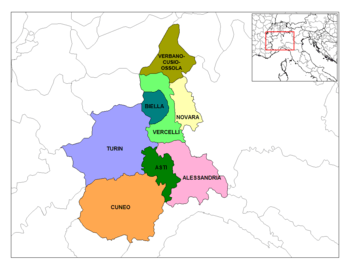
Piedmont is divided into eight provinces:
| Province | Area (km2) | Population | Density (inhabitants/km2) |
|---|---|---|---|
| Province of Alessandria | 3,560 | 431,885 | 121.3 |
| Province of Asti | 1,504 | 219,292 | 145.8 |
| Province of Biella | 913 | 181,089 | 204.9 |
| Province of Cuneo | 6,903 | 592,060 | 85.7 |
| Province of Novara | 1,339 | 371,418 | 277.3 |
| Metropolitan City of Turin | 6,821 | 2,291,719 | 335.9 |
| Province of Verbano-Cusio-Ossola | 2,255 | 160,883 | 71.3 |
| Province of Vercelli | 2,088 | 176,121 | 84.3 |
Culture
Languages
As in the rest of Italy, Italian is the official national language. The main local languages are Piedmontese, Insubric (spoken in the eastern part of the region), Occitan (spoken by a minority in the Occitan Valleys situated in the Province of Cuneo and the Metropolitan City of Turin), and Franco-Provençal (spoken by another minority in the alpine heights of the Metropolitan City of Turin), like in the Susa valley and Walser (spoken by a minority in the Province of Vercelli and Province of Verbano-Cusio-Ossola).
Sport
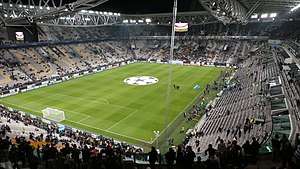
Turin hosted the 2006 Winter Olympics.[21]
In football, notable clubs in Piedmont include Turin-based Juventus and Torino, who have won 38 official top-flight league championships (as of the 2014-15 season) between them, more than any other city in Italy. Other smaller teams include the old "Piedmont Quadrilateral" components Novara, Alessandria, Casale, Pro Vercelli. With the pre-World War II success of Pro Vercelli and the dominance of Torino during the Grande Torino years and Juventus in more recent times, the region is the most successful in terms of championships won. Also Casale and Novese contributed with one scudetto each.
Other local teams include volleyball teams Cuneo (male) and AGIL Novara (female), basketball teams Biella Basketball and Junior Casale, ice hockey team Hockey Club Turin, and roller hockey side Amatori Vercelli, who have won three league titles, an Italian Cup and two CERS Cups.
See also
- Piedmontese language
- 2006 Winter Olympics
- Kingdom of Sardinia
- Battle of Marengo (14 June 1800)
- Battle of Novara (1849)
- Gianduja
- Piemonte (wine)
- Piedmont cuisine
- List of universities located in Piedmont
- Slow Food
- Western Alps
- Bialbero de Casorzo
- Roman Catholic Diocese of Tortona
- Chiusella
- Federation of Damanhur
- Gran Paradiso National Park
References
- "Regional gross domestic product by NUTS 2 regions - million EUR". Eurostat. Retrieved 2 September 2019.
- "Regional GDP per capita ranged from 31% to 626% of the EU average in 2017" (Press release). ec.europa.eu. Retrieved 2 September 2019.
- "Sub-national HDI - Area Database - Global Data Lab". hdi.globaldatalab.org. Retrieved 13 September 2018.
- rai (3 June 2015). "An aerial view of Piedmont" – via YouTube.
- italiano, Touring club (15 June 1976). Piemonte (non compresa Torino). Touring Editore. p. 11. ISBN 9788836500017 – via Google Books.
- Daftary, Farhad. The Ismāʻı̄lı̄s: Their History and Doctrines. Cambridge University Press. ISBN 0-521-37019-1.
- http://www.historyworld.net/wrldhis/PlainTextHistories.asp?ParagraphID=mnn
- Collier, p. 75.
- Valeria Fargion, From the Southern to the Northern Question: Territorial and Social Politics in Italy Archived 23 November 2006 at the Wayback Machine, paper presented at the RC 19 conference 'Welfare state restructuring: processes and social outcomes', 2–4 September 2004, Sciences-Po Paris. Retrieved 7 January 2007.
- Anna Bull, Regionalism in Italy Archived 10 December 2006 at the Wayback Machine, Europa 2(4). Retrieved 7 January 2007.
- Marco Meriggi, (1996). Breve Storia dell'Italia Settentrionale, dall'Ottocento a Oggi. 1st ed. Italy: Donzelli Dditore, Rome.
- "Regional GDP per capita ranged from 30% to 263% of the EU average in 2018". Eurostat.
- "Unemployment rate by NUTS 2 regions". ec.europa.eu. Eurostat. Retrieved 19 September 2019.
- "Tasso di disoccupazione - livello regionale". dati.istat.it (in Italian). Retrieved 19 September 2019.
- "Eurostat". Europa (web portal). Archived from the original on 10 February 2009. Retrieved 23 April 2010.
- Centre, UNESCO World Heritage. "Vineyard Landscape of Piedmont: Langhe-Roero and Monferrato".
- Archived 26 March 2009 at the Wayback Machine
- "Contact Us". www.unicri.it.
- "Eurostat". Europa (web portal). Archived from the original on 21 July 2011. Retrieved 23 April 2010.
- "Sito Ufficiale della Regione Piemonte: Giunta regionale". Regione.piemonte.it. Archived from the original on 18 February 2010. Retrieved 23 April 2010.
- "Turin wins 2006 Winter Olympics".
Sources
- Collier, M. (2003) Italian Unification, 1820–71, Heinemann: Oxford. ISBN 9780435327545.
External links
| Wikimedia Commons has media related to Piedmont. |
| Wikisource has the text of The New Student's Reference Work article "Piedmont". |

- Regional government website (in Italian)
- . New International Encyclopedia. 1905.
